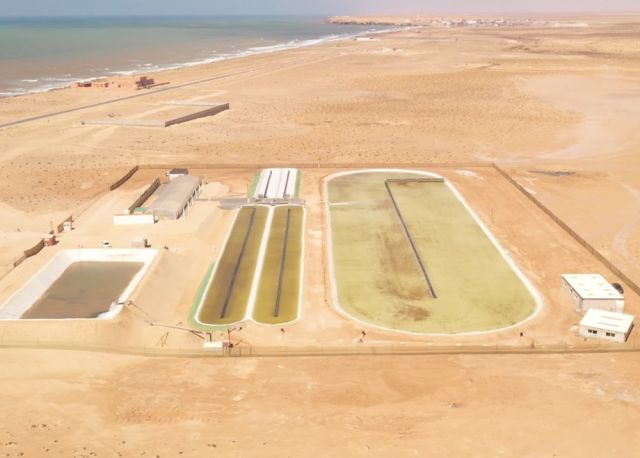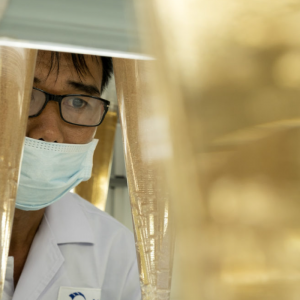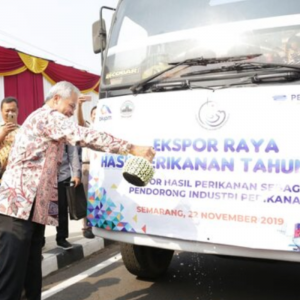
Sustainable Aquaculture to Feed The World
| Tue, 31 Dec 2019 - 11:23

Microalgae-based feeds could avoid depleting the wild fish that farmed seafood consumes, steering aquaculture in a new direction, reports Bonnie Waycott.
Aquaculture has long positioned itself as a promising and alternative to wild-caught seafood and is playing a major role in meeting consumer demand – but the use of forage fish such as anchovies, herrings and sardines are still generating concern.
Cutting forage fish from the diets of farmed species is no easy task as they are a key food source containing much-needed fats – omega-3 generally, but docosahexaenoic acid (DHA) and eicosapentaenoic acid (EPA) in particular. But forage fish get these in the first place from the primary producer of almost all long-chain omega-3s – marine microalgae. This has led one company to bypass forage fish and turn to microalgae in order to produce a fishmeal and fish oil alternative.
Established in 2013 by Dr. Raffael Jovine and Keith Coleman, SuSeWi built its first small-scale pond in South Africa. In 2015, it began working in Morocco, which has good climatic growth conditions, deep and accessible nutrient-rich water, and is close to European aquaculture markets. In 2017, it received equity investment and a grant of over £400,000 from Innovate the UK to develop technology to analyze, select and grow microalgae in Morocco. At the end of the following year, SuSeWi announced the completion of its pilot plant in Morocco. Measuring 8000m2 in area and 4000m3 in volume, it operates the world's largest, single algae raceway pond using patented technologies.
"The idea behind SuSeWi came about after the Virgin Earth Challenge, which challenged scientists to find a way of capturing and storing a billion tonnes of carbon," said CEO Keith Coleman.
"Raffael, our chief scientist, had studied the phenomenon of carbon capture with algae and invented a way of growing it on a huge scale. This involved inducing it to grow exponentially as it would in the sea. He thought about how algae grew in nature and found a way to copy that. The method of natural growth is key to SuSeWi's unique ability to grow algae at scale. We also thought hard about what you can do with microalgae.”
Having recognized its different uses, including biofuel, bioenergy, cement, oil and plastic production, Jovine and Coleman realized that microalgae could have significant impacts on aquaculture.
"We went through a lot of different markets and looked at all the algae markets out there," he said.
"We also looked at those which were structurally attractive, or where the demand for algae-based products far exceeded supply and where algae had a solution to a very pressing world need. The answer was aquaculture. The industry may be growing, but it still needs forage fish to feed its own fish."
"Microalgae is already the natural food of fish fry in hatcheries, so we felt confident that our products would find support in the market. Microalgae is already being used, there is a demand for more of it and we wanted to go after a single, very large market segment. The fish feed market was the obvious answer."
SuSeWi works with two main algae strains - Chaetoceros and Thalassiosira. A chain-forming diatom, Chaetoceros has a fast growth rate, high protein content and high EPA and DHA, while Thalassiosira is a free-floating single-celled algae with a high lipid content and intermediate growth rate. Local algae species in Morocco are selected by SuSeWi's scientists, who then study factors such as protein content, cell, nutrient values, growth rate and ease of harvest before choosing which species to work with.
SuSeWi's technology replicates the natural system, using only seawater, carbon dioxide from the air and energy from sunlight for the pumps and operations.
"We create the conditions for exponential growth for the algae first in the laboratory, then in our controlled greenhouse and finally in large, outdoor raceway ponds where we replicate natural algal bloom conditions," he explained.
After harvesting, the last step is a drying process and the end result of a powder product for the salmon and trout market – a highly nutrient-rich additive that aids growth and survival.
"With support from Innovate UK, we've run feed trials in conjunction with Plymouth Marine Laboratory. Our results have been spectacular. The question before we began was how close we could get to fishmeal in terms of performance. We out-performed fishmeal! The salmon and trout accepted the diets readily, with no adverse effects on behavior, intake or gut health. They displayed higher specific growth rates and better feed conversion ratios compared to the control diet, which was an industry-standard fishmeal-based feed."
In their efforts to develop a microalgae feed, Jovine and Coleman also made sure that they understood exactly what salmon and trout want to eat and their protein and nutrient profiles, before matching their algae to those profiles.
"We don't start with algae before looking for a market," Keith Coleman said. "We start at the market and then look for the algae. We can do this because our system is incredibly productive and flexible, so much so that we have been developing the algae species we grow based on market demand."
Jovine and Coleman believe that from now on, the ingredient will play an increasingly important role in seafood production.
"Algae is generally about 20 times more efficient than land-based plants in capturing and storing carbon, and our product, therefore, performs better than other alternative proteins in terms of its carbon footprint. Aquaculture is under immense pressure to include low marine content feed, in particular, no fish content, and we are perfectly qualified to address this. We offer a highly sustainable source of feed, and we're attracting a fair amount of interest from a range of players. Microalgae also appeal to customers who are looking for sustainable, healthy, non-fish-fed fish, while retailers are pushing very hard for that kind of product on their shelves."
SuSeWi plans to work further on fine-tuning its feed recipes in a way that balances the nutritional needs of farmed fish. It's also looking at how to scale up its production system by engaging with engineering firms and undertaking R&D on the product side with potential customers. Some key components of SuSeWi's approach are flexibility and the ability to grow multiple classes of algae in parallel for a variety of customers.
Microalgae-based feeds mark the beginning of a significant change in how fish are farmed -- one that relies much less on the ocean's resources and enhances the sustainability of salmon and trout farming. As research into microalgae continues, companies such as SuSeWi will have even more to offer in creating a sustainable future for aquaculture.
Source: Worldfishing






















